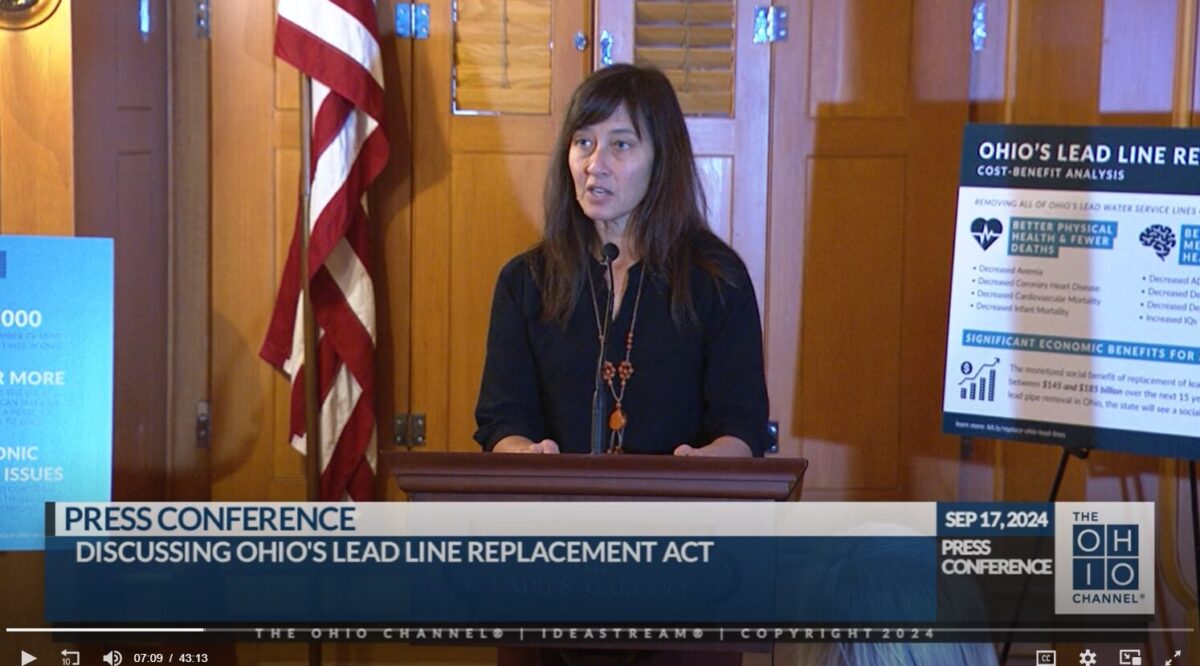Today, clean water advocates spoke out in support of Ohio’s Lead Line Replacement Act (HB 534), a bill designed to get the lead out of Ohio’s drinking water systems by eliminating lead water service lines within 15 years. The bill, introduced by Ohio State Rep. Dontavius Jarrells, includes key provisions that support workforce development and ensure low- and moderate-income customers will not be burdened by the cost of replacement.
Lead exposure from consuming contaminated water can cause irreversible brain damage in children that may take years to emerge. The Center for Disease Control and Prevention has determined there is no safe level of lead in children. Ohio currently ranks third in the nation for the most lead pipes serving families.
Meleah Geertsma, Director of Clean Water & Equity at the Alliance for the Great Lakes, spoke in support of the bill at today’s press conference in Columbus, Ohio. Her remarks are below.

My name is Meleah Geertsma, and I am the Director of Clean Water and Equity at the Alliance for the Great Lakes. The Alliance is a regional organization committed to protecting the health of the Great Lakes and the people and communities that depend on them.
I’m honored to be here today to support Representative Jarrells on this critical infrastructure and public health measure.
My son was born 10 years ago – just a few months after Flint, Michigan, switched its source water and triggered a crisis that would drive a national reckoning with lead in our drinking water.
At the time, I was working at a national organization and I focused largely on air pollution. I also worked with people directly involved in Flint and started doing water work myself.
From that vantage, I saw the harm being done to Flint and other communities like it. I also dug deep into the science and data behind lead in drinking water, learning how we’d failed as a country to adequately test for and control lead.
From my public health training, I already knew that there is no “safe” level of lead exposure. The arrival of my son, however, elevated the issue from a place of professional concern to personal and parental anxiety.
I learned that lead levels in drinking water can vary hugely from minute to minute and day to day and house to house even within the same water system. So having a “passing” test on one day from a few houses in the system is no guarantee that the system’s water is safe for all consumers.
And I learned that on the whole, Great Lakes water systems hover just below the older, inadequate federal action level – meaning that they have significant amounts of harmful lead in their water.
In sum, I confirmed that the only way to truly protect people from lead is to remove it completely from the system.
At the time, I took some comfort because I also learned that it was unlikely our large condo building where my son spent his first critical three years had a lead service line – because the metal is too soft for larger lines serving larger buildings.
So I was able to make his formula without fearing that I was inadvertently harming him by mixing the powder with our home’s water.
My son turned three in 2017 – while I was working on a bill in Illinois that would require replacement of all lead service lines, like the bill we’re here to support today.
That summer, we bought our first house in an inner suburb of Chicago. It was 100 years old and had been owned by the same family for 60 years – with minimal updates. And it had a lead service line.
From the day we moved in, I worried that our drinking water would hurt our son. We replaced all the faucets and added an under-sink filter to the kitchen, and made sure to get our son tested for lead regularly and monitored his development. And every time he threw a tantrum or fell behind in school, I worried it was the water – and our fault.
We’re lucky and privileged – we live in a community with a relatively well-funded and capable water department. We knew to take protective measures and to closely monitor our son, and we had financial resources and specialists available. Today, our son is okay, with no visible impacts of lead.
But not everyone has the resources or the information that we did – nor should people have to rely solely on their own resources to protect themselves and their families against a public health emergency that arises from water infrastructure, or worry that their child will be poisoned when visiting a friend’s or family member’s home.
While I know from personal experience the guilt and helplessness a parent can feel when struggling to protect their child, I also know that access to clean water is a fundamental right that can only be secured if we demand change and work together to solve the problem.
Flint happened 10 years ago – that’s a full decade. The time to get the lead out is long past. As my son would say “Let’s Go!”
